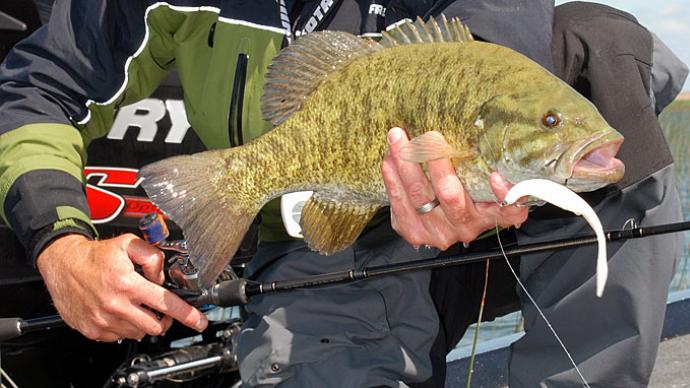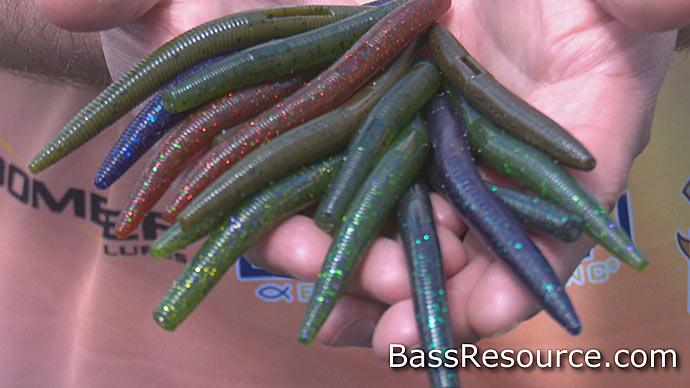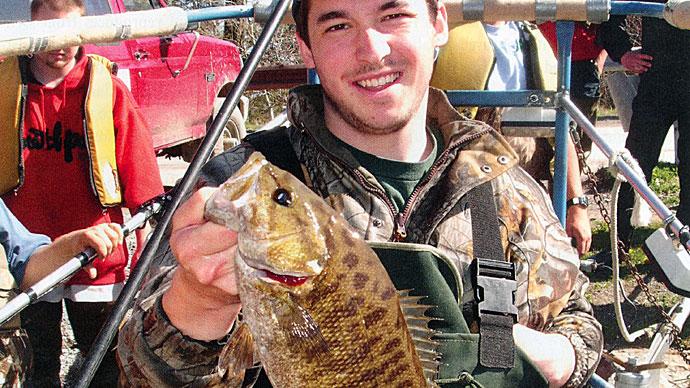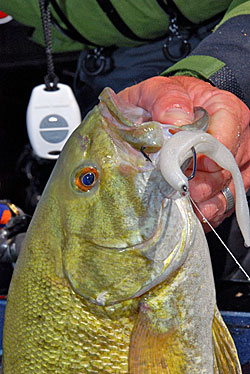
The dictionary defines the word fluke as a “lucky accident.” If you’re a bass angler and use a fluke, you’ll get lucky, but it won’t be by accident.
Flukes are one of the most versatile lures in a bass angler’s arsenal. The most common way of fishing a fluke is to rig it Texas-style, without weight, and fish it with twitches and jerks to walk the dog and imitate a dying or distressed baitfish. If you’ve ever seen a dying shad or alewife, you’ll realize that a fluke imitates a dying baitfish's darting, shuddering quiver. But that’s not the only way to fish a fluke. You can use them when drop-shotting or rig them on a jig head. You can also use a weighted hook to fish the fluke somewhere in between.
Flukes excel in clear water situations like those found on the Great Lakes and pristine natural lakes. Clear water is essential because visibility is critical for the bass to see your fluke and for you to see the bass when they bite. Polarized glasses are a huge benefit and necessary gear when fishing flukes.
“I think a fluke works best towards the tail end of the spawn and post-spawn,” offered tournament pro, Scott Dobson. “I fish mainly for smallmouths, so I’m going to use a fluke in clear water situations in places like the Great lakes and larger clear, natural lakes. I think clear water is important because of its visibility to the fish and fishermen. Most of the time, you’re going to be fishing a fluke just under the surface, and the fish will come up for it. ”
With that in mind, Dodson joked, “You can use any color fluke you want as long as it’s white or pink. I guess it’s a sensory thing where bass can see those colors best, and so can the angler.” Dobson said he typically works a fluke with sweeps and twitches of the rod tip that produce an erratic side-to-side darting, swimming motion. 95% of the time, you’ll see the bite if you’re paying attention, especially with the highly visible colors Dobson uses. The fluke will just disappear. This scenario works best in clear water where you can see. One advantage is you can cover water, and fish can see the bait from a distance when using flukes.
While there are multiple ways of rigging and fishing flukes, Dobson relies on a simple, un-weighted Texas rig for most of his fluke fishing and uses a 5.25-inch salt-impregnated Zoom Super Fluke (zoombait.com/super-fluke) nearly 100% of the time. Zoom claims, " The Super Fluke's deep belly causes it to dart, glide, and knuckleball through the water, while its universal baitfish size allows it to tempt both limit-sized bass and the biggest fish on your lake. It is rigged weightless, it skitters across the surface like an injured shad, but a belly-weighted hook or some insert weights allows you to employ it as deep as necessary.”
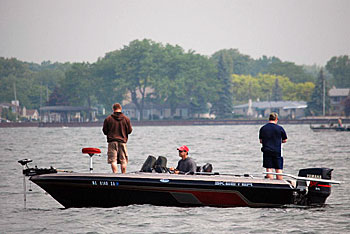
The history of the Zoom fluke goes way back to 1991. Today dozens of manufacturers make fluke-type lures, including Lunker City, Kalin, Berkley, Northland Tackle, Strike King, Z-Man, Yum, Lake Fork Trophy Tackle, and Mann’s, just to name a few. Many have a split tail; some have a whiptail, and others a paddle tail. Each produces a slightly different action. The whiptail produces a fluttering action as it falls and less of a side-to-side glide than the split-tail. Paddle tails, either horizontal or vertical, zoom off to one side when twitched and then back again, but don’t match the walking-the-dog darting motion that traditional split-tail flukes do.
Dobson believes that using the right hook is critical to your hook-up ratio when using flukes. “I use a Gamakatsu 5/0 Superline Offset Shank EWG Worm Hook when fishing flukes. The 2x-strong, high-carbon heavy-wire hook is a little heavier and causes the fluke to sink without adding weight. It also adds more resistance when you want to set the hook.”
Dobson said that he learned how important it is to have the right outfit for fishing flukes over the years. “When I first started fishing with flukes a year ago, I had a 6 foot 6-inch rod and a reel that might have had a 5 or 6 to 1 gear ratio, and my hook-up percentages with flukes were terrible. Having the right rod is crucial for manipulating the bait, but it’s a big help when setting the hook. A high-speed reel will help because the way a fluke moves, you might have three or four feet of slack to take up before you make contact with the fish.
Dobson’s favorite rod for fishing flukes is a 7-foot 3-inch medium/heavy Dobyns Rods Champion Series DC 734. The added length and backbone comes in handy for sticking belligerent brozebacks. He matches that to a low-profile Shimano Curado CU201IHG bait-casting reel. “Any bait-casting reel with a 7:1 or faster gear ratio will work,” he said. Dobson fills the reel with 14-pound Sunline fluorocarbon.
There are times when Dobson said he uses flukes on a drop-shot rig. “I like the Strike King Strike King 3X ElazTech Z Too when the fish feed on bigger baits. The Z-too floats, and it is made of ElazTech, so they’re really tough. It’s good when the bass feed on alewives or shad in the deeper main lake basin, and we’re fishing vertically. The Arkansas Shiner and Smoky Joe are good colors.”
Another fluke-style lure that Dobson relies on is Strike King’s 5-inch KVD Perfect Plastic Caffeine Shad. “The Caffeine Shad is good when looking for a bigger profile. It’s also a good bait to nose-hook when fishing for schooling bass.”
Although two of the best ways to fish a fluke are with a classic Texas rig or anchoring it with a drop shot, there are alternatives. Add the fluke to a weighted, wide-gap hook gets the lure slightly deeper and allows you to work it faster and drive it into a stiff wind. Adding the fluke to a jig head allows you to imitate the head-down posture of a feeding minnow or swim it seductively along the bottom. Adding sections of lead nail weights to a fluke can produce a head down or tail first attitude that can trigger predators.
Any way you cut it, catching bass on a fluke can’t be considered a lucky accident.


